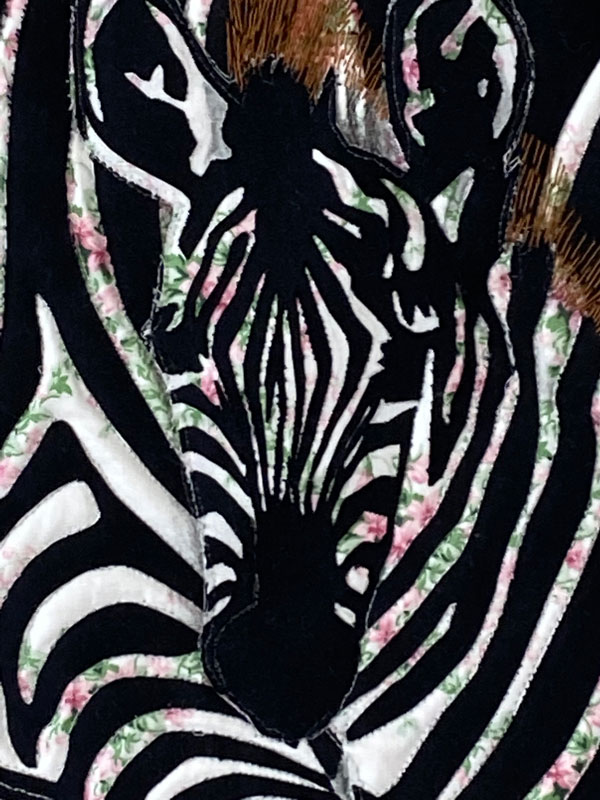Ministry in Africa inspires fabric design artist
Sister Josephine Niemann, SSND was born in Effingham, Illinois, USA. Following her first profession in St. Louis, she has devoted her entire ministry as a teacher and artist. After 15 years of teaching art, English and religion, she felt called to the same in Sierra Leone. That was truly a broadening experience for her.
Here are some of her quilts and the inspiration for its creation.
Tie-dye Quilts
When Sister Josephine ministered in Sierra Leone in the late 70’s she greatly admired the tie-dye fabrics she saw many people wearing. She visited one of the women in the neighborhood who was involved in the creation of the cloth and learned from her the process of folding, hand stitching and dyeing the beautiful designs. Later in the 90’s she adapted the process to create quilts, which were raffled for the former School Sisters of Notre Dame St. Louis Province, now Central Pacific Province.
Creation Mandala

This whole cloth quilt was folded in half four times, then machine sewn through the sixteen layers of fabric with a basting stitch to create a mandala design of birds and flowers.
Gossamer Webs


This quilt was created with tie-dye blocks, again by folding the fabric four times and stitching through the sixteen layers with a sewing machine for a design similar to paper snowflakes, but with the dyeing looks more like spider webs.
Animal Quilts for MicroFinancing Partners in Africa (MPA)
When Sister Josephine was asked to join the MPA Religious Advisory Board, she jumped at the chance simply because everything African is still dear to her heart, having ministered in Sierra Leone in the late 70’s and early 80’s. Once she learned more about the charitable organization, she was thoroughly committed. MPA corresponds wonderfully well with our SSND charism. MicroFinancing Partners in Africa raises money to give to partners in Africa who administer projects that enable the people to pull themselves out of poverty. The process always involves education of the recipients of the loans so that they are prepared to succeed. Each participant is required to pay forward to another what she or he was lent. Thus each donation keeps on giving.
The Exuberance of Motherhood
This wall quilt, inspired by a photo taken by Julie Gunlach, was auctioned at MPA’s Gala in April 2021. The circle prints and floral fabrics express the delight of the mother elephant in her child.
When making this quilt, again inspired by a photo taken by Julie Gundlach, Josephine was curious why zebras have black and white stripes, which seemingly make them more visible to prey. After research, she wrote her musings as the outlines of the foliage in the quilt:
Aren’t Zebras Fantastic
Aren’t zebras fantastic creatures? But why in the world do zebras have black and white stripes? Are they just a whimsy of God? The colors and textures of most animals help them blend into their surroundings and make them hard to see—camouflage. Black and white stripes call for attention. Look at me! Stark contrast stands out. Hides nothing. But look at a mass of moving zebras. A dizzying sight! Who wants to chase that? But you know, maybe God just wanted a good laugh!

Did you know that zebra stripes evolved to keep biting insects away? Flies eyes have thousands of photoperception units that distinguish brightness and color. The many black and white stripes repeated thousands of times confuse the flies. The stripes also prevent zebras from overheating in the African sun. Because air moves at different speeds over light absorbing black and light reflecting white, zebras create their own air cooling currents. One more thing: like human fingerprints, the pattern of the stripes is different on each zebra. This provides a means of identifying individuals in a herd. How easily could a young zebra lose its mother if that weren’t so?
Sister Josephine continues to support the Province of Africa through the annual quilt raffle. For more information on the quilt raffle, please email ssndafrica@gmail.com. Her artistic talents also extend into custom-made liturgical banners, vestments, alter cloths and other linens for houses of worship for all faith communities. For more information, visit Liturgical Fabric Arts.